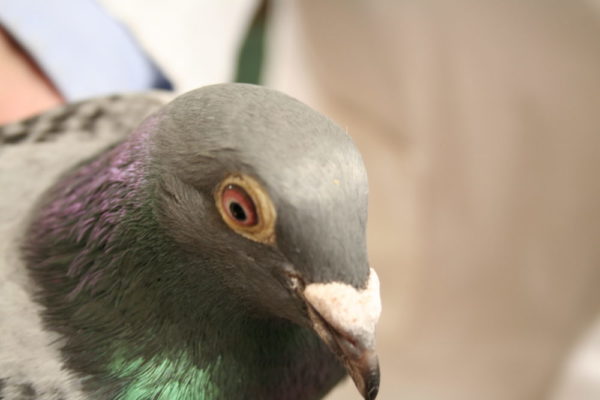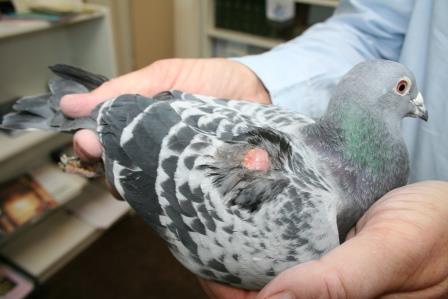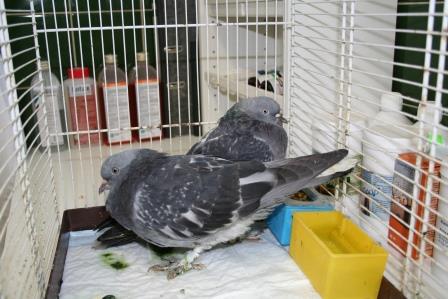

Dead pigeons, a nightmare for every pigeon fancier
Every day for the past 45 years, we have dozens of pigeon racers getting in contact from all over the world. There are very few things we are not asked, and we always listen seriously (sometimes in 5 languages) to the many problems.
White caps
I once had a Portuguese pigeon fancier on the phone years ago who was adamant that his pigeons had a new disease. They had ‘white caps’ and since then, they weren’t flying well. Nobody in Portugal knew what to do so he had packed a couple of pigeons, took the plane and arrived in Breda. Of course, I had already told him on the phone that this was a ‘mechanical’ problem. Scraping the top of the head against the roof of aluminium baskets which are too low causes localised wear of the feathers. The ‘clever chap’ didn’t believe that and he wanted to come to Breda anyway! No sooner said than done. Under the microscope I was able to show him how the ends of the small feathers on the head lap over each other like tiles on a roof and that exactly on the outer edges the wear was visible which produced the white aspect. So, there’s nothing wrong, this has nothing to do with its health.

I also explained to him that one half of pigeon fanciers says: “When the white caps start to appear, form is gone“, while the other half of the fanciers says: “When the white caps appear, it’s form is coming“. This is also logical because the speed men who have widowed the pigeons weeks before the season, fly about 5 races well and then less well (more a question of blocked nasal passage) and the other part deliberately starts later to prepare the pigeons for the farther races (midfond, one day)!
Paratyphus
So you can see that, provided you have a good understanding of things and an immense amount of experience, you can even solve many issues by telephone. I once also had clients from the Urals (Russia) with a basket of show pigeons. The poor animals had paratyphus and they had no effective medicines against it. Show pigeons are more sensitive to Salmonella (paratyphus) than our racing pigeons. They are hardly treated for it in so-called third countries, so the threat of infection is in principle higher and there is of course much less selection for vitality. In general, vaccines against paratyphus generally do not work well enough.

Ornithosis
The majority of the questions are about poor performance after about 5 flights. This is almost always due to ‘blocked nasal passage’, a form of ornithosis!
Pigeon deaths
Another important part of the problems is the death of youngsters in particular!
We can list the causes of the sometimes high mortality in youngsters. We have learned to ‘ask out’ the problems as much as possible, so: what are the symptoms? How long have they existed? How many pigeons are sick? At what age did the problems start? How many have died? How long does the whole disease process take? If things go fast, then they’re not thin. Or if it goes slowly, they are emaciated. What do the droppings look like? Green/yellow slimy? Are the pigeons vomiting? Do they drink a lot (too much)? Are they vaccinated against Paramyxo and if so, with which vaccine and how long ago? Are there any nervous symptoms? Other specific symptoms?
We have found that in some places there is a severe abnormal E. coli infection, sometimes exacerbated by a PMV infection without nervous symptoms. The pigeons die very quickly and ‘everyone’ thinks we are dealing with a new virus. This includes German veterinarians of the Pigeon Clinic and even the University of Hannover. I reported about that before. It was assumed that we were dealing with a new virus, but when the fanciers contacted us, our diagnosis was a serious E. coli infection that with the right antibiotics stopped the trouble within 3 days. We have seen dozens of such cases in the Netherlands, Belgium, Germany, England and France. By the way, we almost always have the pigeons re-vaccinated against PMV with an aqueous vaccine!
Pigeon congress Krakaw
I was able to tell my practical story about all these problems with our racing pigeons at a prestigious pigeon congress in Krakow, Poland. The organisation had set aside no less than two hours for my lecture. In that short time, I managed to review a lot of diseases. There were very interesting scientific lectures on bird flu (avian influenza), Paramyxo and rotavirus infections.
Rotavirus in Australia
According to researchers, led by Dr Colin Walker, the rotavirus has been responsible for major problems with old and young pigeons, including rapid death, over the last eighteen months (2017/2018) in Australia. When I was consulted by Australian veterinarians last year in the middle of a live radio broadcast from Australia, the whole story reminded me very much of the deadly adeno type 2 infection I saw in West Brabant in 1991. Thousands of dead pigeons within a day of becoming ‘sick’! The main symptoms being, apathetic behaviour, bright yellow droppings, not eating, little drinking and total slackening (sponginess) of the pectoral muscles. Acute mortality within 18 hours while panting heavily. According to the Australians, the Victoria Pigeon Rotavirus infection was just like this!
In 2017, German researchers published an article in the German Association magazine “Die Brieftaube” on the situation in Australia. In 30% of the cases it turned out to be Paramyxo , which didn’t surprise me at all, because that is what we often see in Europe. Our diagnosis of this type of rapid death is E. coli, sometimes in combination with PMV. Which requires the right antibiotic plus an emergency vaccination against PMV, preferably with a aqueous vaccine and preferably not with a white oil adjuvant vaccine! We saw a very rapid improvement in 90% of the cases. The mortality stopped almost immediately after the 5-day course and the PMV vaccination. Even if they have already been vaccinated, it is highly recommended to re-vaccinate them.
The same German researchers went looking, in close consultation with Dr. Colin Walker, for rota viruses in sick and dead youngsters in Germany who had symptoms of ‘adeno-coli syndrome’, also called ‘Young Bird disease’ internationally. Especially in those cases where rapid death occurred. And indeed, in some cases rota viruses were also found. The research is in full swing and the results are not yet easy to interpret.
As you know, about 10 years ago ‘everyone’ (except me) was extremely alarmed about the circovirus. According to many, that was the cause of ‘just about everything’ in terms of pigeon outbreaks, including ‘adeno-coli’. But that turned out to not be the case, which didn’t surprise me at all.
Rotavirus in Europe
And finally the rotavirus. From our practice in Colchester near London, I have got to know the rotavirus for a number of years. This sometimes appears in section reports from laboratories we have consulted. This virus never did surprise me in the sense that I thought it was the cause of big problems! I have never seen much mortality from this virus and certainly not comparable to the Australian Victoria Pigeon Rota Virus.
When Dr. Colin Walker asked me last weekend in Krakow what I thought of the discovery of rotavirus in sick and dead youngsters in Germany, I answered him respectfully that I hoped and assumed that we here in Europe, despite the discovery of rotavirus, could not conclude that rotavirus would suddenly be the cause of the indeed sometimes fast killing course of the ‘Young Bird Disease’ (adeno-coli syndrome) all the more because, unlike in Australia, old pigeons rarely die from this. What we do see in the last 15 years is that even old pigeons can also get a very mild form of ‘adeno-coli’. Those first cases came to me for a consultation about 15 years ago on a Sunday morning from the Saar region (Germany)! However, these cases can be cured quickly and effectively with the right antibiotics!
For many pigeon fanciers and veterinarians it’s all a bit complicated, just look at the countless ‘cases’ that we get forwarded.
After all, there are only a few veterinarians in the world who really know about pigeon diseases!! And they come, almost without exception, from the Netherlands, Belgium and Germany. I almost always try to be collegial, but I get more and more annoyed by the unprofessional work of colleagues. And the poor pigeon fancier can’t judge it very well and is just being ‘conned’.

BELGICA DE WEERD B.V. I Postbus 4607 I 4803 EP Breda I Nederland
T +31 76 560 02 22 I F +31 76 565 35 70 I info@belgicadeweerd.com I www.belgicadeweerd.com
